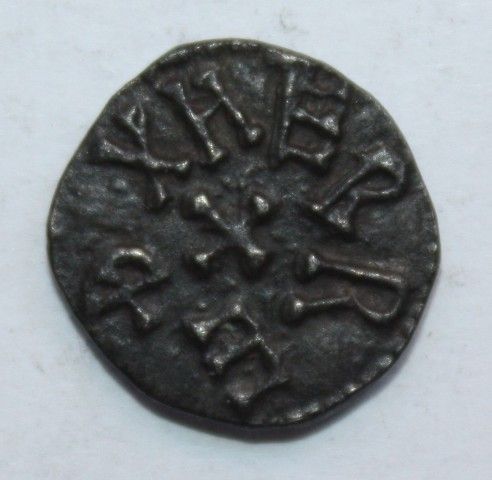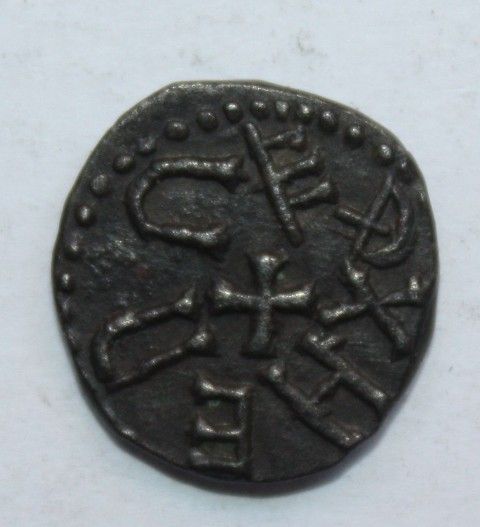Options
Last purchase of 2014
 Nap
Posts: 1,755 ✭✭✭✭✭
Nap
Posts: 1,755 ✭✭✭✭✭
My last purchase of 2014, which just arrived: a double reverse Northumbrian styca of King Eanred's moneyer Herreth
Northumbrian stycas are well known for being crude and, especially in later years, having nonsensical legends. In fact, Spink/Seaby #S.872 is given to all of those coins fitting into the "irregular series."
But this is not a 'typical' blundered styca. In fact it is a mule or deliberately produced "double reverse" coin, depicting the moneyer on both sides, of good style, and from an earlier period than the later civil wartime irregular stycas.
Double reverse coins are not common in the styca series. There are three pairings described:
1) Double reverse of Herreth
2) Double reverse of Aethelweard
3) Mule of Herreth/Alfheard
CNG just sold a double reverse styca of Aethelweard here. I did not win the lot.
Despite the crudeness of Northumbrian coinage, these are really the only major double-reverse mules known for the series, besides later heavily blundered types.
The manufacture of coins was presumably a structured process, given the many thousands of coins produced. The lower die is presumed to have been mounted on some solid piece of wood or anvil, thought to perhaps be via a spike that could be driven into the wood, holding it fast in place. The obverse die would be held with one hand, the hammer with the other. It's not known for sure if this is how manufacture took place, but it is a reasonable assumption that both dies would not be loose and subject to considerable movement during striking.
So for a double-reverse pairing to take place, a reverse die would have been mistakenly manufactured as an obverse die (without the spike), then paired with a normal reverse for striking. This makes some sense, as double obverse pairings are exceedingly uncommon in the styca series, and quite rare overall in medieval and ancient coins. Or this could have been a deliberate act of manufacture by a moneyer who believed the king held no authority over him. Certainly the true meaning will never be known.


Seller's images. Haven't had a chance to photo it myself.
Both sides read XHERRED (with strike through the D)
The first reverse die is known to be paired with normal obverses of King Eanred, as well as other dies reading 'XHERRED', probably suggesting that it was manufactured as a reverse die. The second reverse I have been unable to find elsewhere. It is different than other dies used in the HERRED/HERRED mules. So perhaps this was an intentional manufacture, not an accident, since there are multiple die pairings.
Further reading can be found in "Herred" by D.M. Metcalf and J.P. Northover, in "Coinage in Ninth-Century Northumbria". This is a difficult book to find, and if anyone is interested, I could photocopy the paper.
Northumbrian stycas are well known for being crude and, especially in later years, having nonsensical legends. In fact, Spink/Seaby #S.872 is given to all of those coins fitting into the "irregular series."
But this is not a 'typical' blundered styca. In fact it is a mule or deliberately produced "double reverse" coin, depicting the moneyer on both sides, of good style, and from an earlier period than the later civil wartime irregular stycas.
Double reverse coins are not common in the styca series. There are three pairings described:
1) Double reverse of Herreth
2) Double reverse of Aethelweard
3) Mule of Herreth/Alfheard
CNG just sold a double reverse styca of Aethelweard here. I did not win the lot.
Despite the crudeness of Northumbrian coinage, these are really the only major double-reverse mules known for the series, besides later heavily blundered types.
The manufacture of coins was presumably a structured process, given the many thousands of coins produced. The lower die is presumed to have been mounted on some solid piece of wood or anvil, thought to perhaps be via a spike that could be driven into the wood, holding it fast in place. The obverse die would be held with one hand, the hammer with the other. It's not known for sure if this is how manufacture took place, but it is a reasonable assumption that both dies would not be loose and subject to considerable movement during striking.
So for a double-reverse pairing to take place, a reverse die would have been mistakenly manufactured as an obverse die (without the spike), then paired with a normal reverse for striking. This makes some sense, as double obverse pairings are exceedingly uncommon in the styca series, and quite rare overall in medieval and ancient coins. Or this could have been a deliberate act of manufacture by a moneyer who believed the king held no authority over him. Certainly the true meaning will never be known.


Seller's images. Haven't had a chance to photo it myself.
Both sides read XHERRED (with strike through the D)
The first reverse die is known to be paired with normal obverses of King Eanred, as well as other dies reading 'XHERRED', probably suggesting that it was manufactured as a reverse die. The second reverse I have been unable to find elsewhere. It is different than other dies used in the HERRED/HERRED mules. So perhaps this was an intentional manufacture, not an accident, since there are multiple die pairings.
Further reading can be found in "Herred" by D.M. Metcalf and J.P. Northover, in "Coinage in Ninth-Century Northumbria". This is a difficult book to find, and if anyone is interested, I could photocopy the paper.
0
Comments
World Collection
British Collection
German States Collection
<< <i>EVP showed me a couple in NYC. These are very neat. I didn't realize how small they were. Congrats. >>
Z - Nap's coins are AE stycas. I have only one of them. They seem only to have been produced by Northumbria. You may be thinking of the AR sceattas, of which I have a handful.
It always struck me as funny that the preeminent Anglo-Saxon power was, for a long time, Northumbria. They were courtly, inspired the arts, and had influence with the Vatican. Yet, their primary coinage was AE, not AR or AV.
And, they were one of the earliest attacked by the Vikings. Go figure.
How does one get a hater to stop hating?
I can be reached at evillageprowler@gmail.com
The earlier sceats are typically of good silver.
<< <i>And, they were one of the earliest attacked by the Vikings. Go figure. >>
I bet they tried to pay off the Vikings like southern England would, but I imagine the Vikings were not incredibly interested in small copper coins with minimal precious metal content.